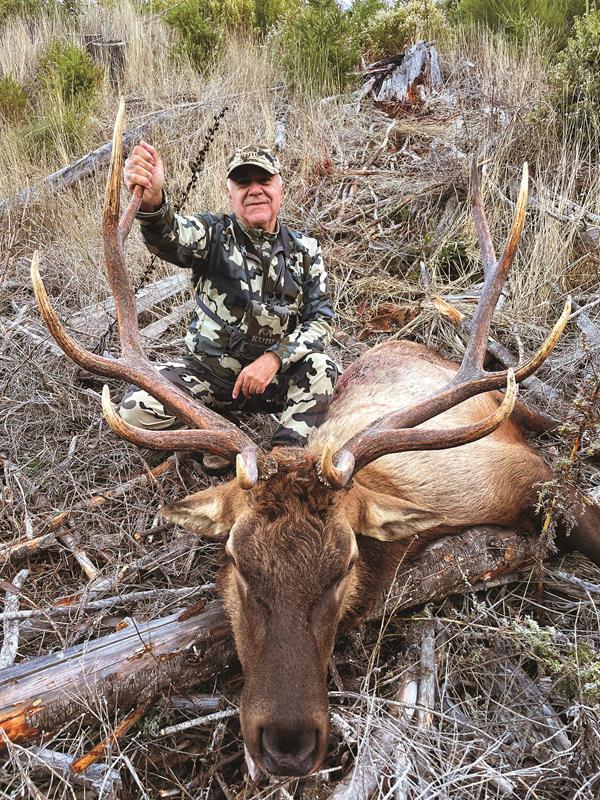
Looking at my accumulated preference and bonus points in early 2022, I was sure I would have a great tag in several states for Rocky Mountain elk, and fortunately, I had accumulated enough points to be drawn for Roosevelt elk in Oregon. The Roosevelt elk, also commonly known as the Olympic elk and Roosevelt’s Wapiti, is the largest of the elk in North America by body mass, reaching up to 1,200 lbs. However, in my opinion, the antlers of the Rocky Mountain elk are more majestic.
The Roosevelt elk’s geographic range includes the Pacific Northwest and extends to parts of Northern California. In December 1897, mammologist C. Hart Merriam named the species after his friend, Theodore Roosevelt, long before he became the United States President. The desire to protect the Roosevelt elk was one of the primary forces behind the establishment of the Mount Olympus National Monument in 1909 by President Theodore Roosevelt Fortunately, I drew the tag and booked a hunt with Ken Wilson, the owner of Spoon Creek Outfitters. Interestingly, I had been talking to Ken for the past four years during the application season, and together, we would decide to apply for a tag or just buy a point.
I drove to Coquille, Oregon, got settled in a brand-new trailer, and prepared my gear for the opening day of my season. Early in the morning, Ken drove me to town where I met my guide, Ross Morris. After the introduction and exchange of pleasantries, we took off for the hunt area. The great expanse of the timber companies’ leases that Ken had under contract was truly impressive as we drove for hours in the dark and opened and closed many gates before it got light enough to start glassing. Most of the time, we had been driving in the dark canyons covered with mature timber on both sides, but just as Ross was closing the last gate behind the truck, I glassed the slightly open area above the road. Less than 200 yards away, I saw antlers moving between the trees. I quickly got Ross’ attention and pointed to the elk. He took a quick look in his Swarovski and quietly signaled for me to shoot. I will never forget the short conversation that lasted not more than 25 seconds.
“Kill that bull!” he said.
“Are you sure, Ross?” I replied.
“Kill that bull now,” he said.
I didn’t say a word or look at him after his last “now,” but I usually have several important questions before taking a shot. How big? How far? What does he score? It was only the first hour of the first day of the season, and he was the first bull we had seen. Could we look some more and find a better bull? So many questions for such a prompt instruction to shoot. However, under the excitement, these questions quickly vaporized from my mind. I threw the rifle up and shot the elk in the front shoulder at about 180 yards up the side of the canyon with a steep angle. His right front leg did a 360-degree turn as he jumped over a log. We both knew he was not going anywhere, but I shot him again and he went upside down about five or six feet from where he was when I first shot him. Wow, what just happened? I was in disbelief. After a few seconds, I remembered the very famous saying among professional hunters and one of my own mantras, “Always trust your guide.” When we wiped off the surprised looks from our faces, we did a few high fives and started up the road. While driving, I was wondering how we were going to get to him on such a steep canyon and how we would get him out.
God, the universe, or both, were on our side as there was a very narrow, old, and very short dead end logging road right below the bull. We climbed to where the bull was, and after removing and clearing some of the deadfall, we set him up for some pictures. I then said to myself, “What now?” We were still a long way from the truck, and this was not a small bull.
Ross was all smiles, and he said, “Let’s go back to the truck,” where he opened the tailgate. I realized the reason for his big smile. There was a gigantic spool with 700 yards of very strong rope in the back. He couldn’t have surprised me any better than that. He took the rope and climbed to the bull. We tied it, and I drove the truck down the mountain as he guided the bull through the trees and deadfall. When he told me to stop over the walkie talkie, I untied the rope and drove back. The elk was down the steep hillside all in one piece. This was genius! Later, I found that most of the guides have similar setups for game retrieval in these very steep and heavily-wooded forests.
We celebrated, took pictures, and got busy with field dressing the elk while I was reliving the 35-40 minutes of the first day of the elk season that I had just experienced. How fortunate and lucky I was trusting my guide and not second guessing his judgement. I got my Presidential Elk after years of applying in Oregon. When you get into the application game, it would be a big mistake to quit. My persistence has paid off with a sheep and an elk tag in Oregon, and I will certainly continue to apply until I draw the remaining tags.
I owe a big thank you to Ken for his consultations during the past several years and also to Ross for his help in securing my Presidential Elk. Now, I’m going to go after the Tule elk in my beautiful state of California.